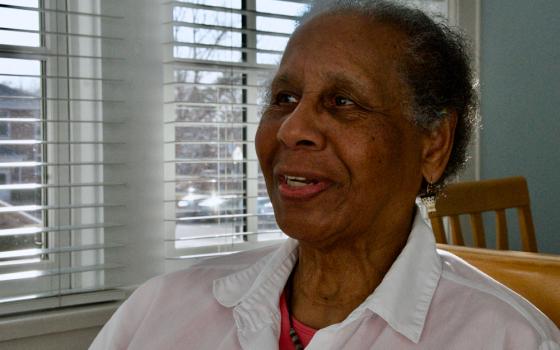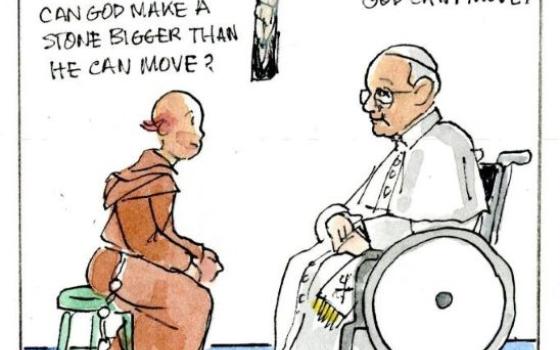By JOHN L. ALLEN JR.
London
The papacy has always been a polarizing force around the world, but you rarely get as clear a physical demonstration of that fact of life as the streets of London offered today.
At roughly the same time that some 80,000 pumped-up youth thronged Hyde Park for a prayer vigil with Benedict XVI, an estimated 10,000 to 15,000 secularists and atheists, gay rights activists, victims of sex abuse and others marched through the city for a “Protest the Pope!” rally.
Famed atheist Richard Dawkins, who had earlied suggested that Benedict XVI be arrested while in the U.K. for his role in the sexual abuse crisis, was among the speakers at the rally, where he called Joseph Ratzinger an "enemy of humanity."
Even though the pope’s supporters clearly outnumbered his critics, this was nevertheless easily the largest public protest Benedict XVI has ever faced on one of his foreign trips, and one of the largest protests against a pope in modern history.
The turnout exceeded organizers’ expectations and straining the resources of the police on hand, who clearly expected a smaller group.
In one of the evening’s ironies, a small knot of protestors who had attended a separate rally to oppose the stoning of Sakineh Mohammadi Ashtiani in Iran decided to join those opposing the pope – despite the fact that Benedict XVI and the Vatican have condemned plans to stone the Iranian woman.
Up to this point, most protests facing Benedict on Sept. 16-19 trip to the United Kingdom have been strikingly small, usually numbering no more than a few dozen activists. The trip finishes tomorrow in Birmingham with the beatification of Cardinal John Henry Newman.
Banners held aloft as a succession of speakers criticized the pope for his handling of the sexual abuse crisis, as well as his positions on gay rights and contraception, sported slogans such as “Benedict’s homophobia costs lives!”, “Benedict soft on Holocaust deniers!” and “Justice for Victims!”
British wit was also on display, as one woman scandalized by the sexual abuse crisis carried a sign that read, "No Pope, No Grope!"
Having fiercely pro- and anti-pope crowds in such close proximity could be combustible, and there were a few minor skirmishes as the “Protest the Pope!” crowd marched through London. At one point a small group of papal devotees unfurled a Vatican flag, which was wrested away by irritated protestors.
For the most part, however, the two groups left one another alone – perhaps a reflection of the fact that in many ways, they live in different social and philosophical worlds.
Asked earlier in the day if he was surprised by the harsh language of the protests, the Vatican spokesperson, Fr. Federico Lombardi, played down the opposition.
“This is the democratic tradition of the U.K.,” Lombardi told reporters. “I’m not surprised, not shocked.”
Lombardi said that in general, he was struck by the “very, very large” number of people who are “happy to meet the pope and to express great joy.”
“The positivity,” Lombardi asserted, “is immensely superior to the protests.”
Like the pope himself, the trip to date seems to be drawing sharply contrasting reviews.
British Catholic commentator Austin Ivereigh, co-founder of a media operation for the trip called “Catholic Voices,” said that Benedict’s trip is going “fantastically,” that the British public is listening as the pope offers “the greatest argument against secularism ever made in this country.” Terry Sanderson, meanwhile, president of the National Secular Society, predicted that the trip will be “totally forgotten” as soon as it’s over because most British people are “indifferent” to the pope.
The Hyde Park event was a vigil service to prepare for tomorrow’s beatification of Newman, a great 19th century theologian, apologist, and convert from the Anglican church to Roman Catholicism.
Recalling the British legacy of Catholic martyrs, Benedict suggested to the youth that martyrdom continues today, albeit under other forms.
“In our own time, the price to be paid for fidelity to the Gospel is no longer being hanged, drawn and quartered,” the pope said, “but it often involves being dismissed out of hand, ridiculed or parodied.
Benedict argued that Newman’s life and example confirms that “the Church cannot withdraw from the task of proclaiming Christ and his Gospel as saving truth, the source of our ultimate happiness as individuals and as the foundation of a just and humane society.”
That call to Catholics to take their place in the public square has been a great theme of Benedict’s four-day trip, part of a strategy to combat what Benedict sees as an “aggressive secularism” that seeks to marginalize religion and to treat religious faith as an exclusively private matter.
“Truth is passed on not merely by formal teaching, important as that is, but also by the witness of lives lived in integrity, fidelity and holiness,” Benedict said.
“Those who live in and by the truth instinctively recognize what is false and, precisely as false, inimical to the beauty and goodness which accompany the splendor of truth,” he said.
Editor's Note: This blog posting originally misidentified Cardinal John Newman as an Anglican convert from Catholicism. Newman, of course, converted from Anglicanism to Roman Catholicism. Thank you to those commenters who alerted us of the error. We have corrected it.
John Allen will be filing reports throughout the Papal visit to the U.K. Sept. 16-19. Stay tuned to NCR Today for updates.




